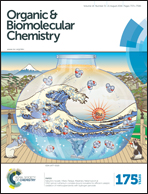Detection and quantification of ATP in human blood serum†
Abstract
Two fluorometric sensors based on the tri-serine tri-lactone scaffold and thiourea or sulfonamide moieties serving as hydrogen bond donors allowing for anion binding are described. The sensor utilizing thiourea as a recognition moiety shows fluorescence enhancement while the sensor with sulfonamide shows quenching upon addition of phosphates. Sensor arrays composed of two sensors are able to discriminate structurally similar organic phosphates in the presence of interferents in human blood serum. The quantitative analysis of ATP in human blood serum shows high accuracy (the root mean square error of prediction, 1.65%) without requiring any sample pretreatment.


 Please wait while we load your content...
Please wait while we load your content...